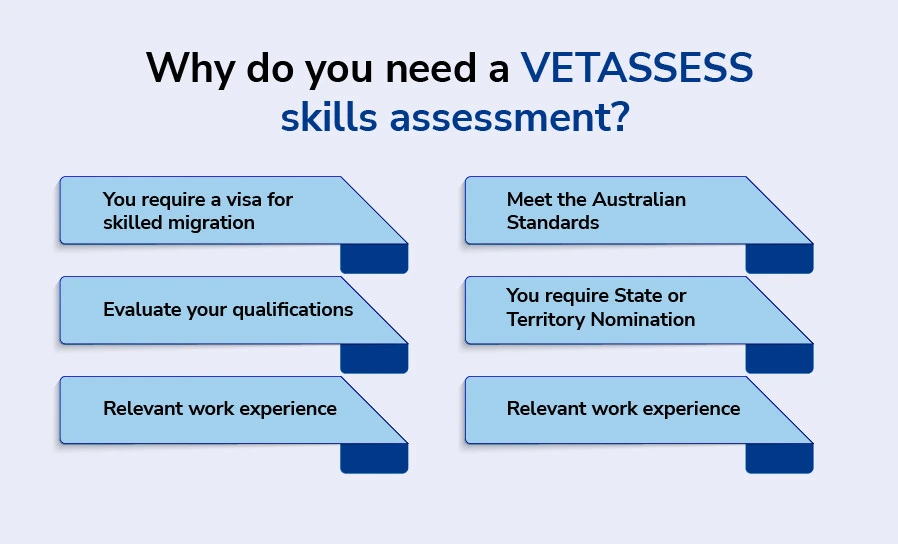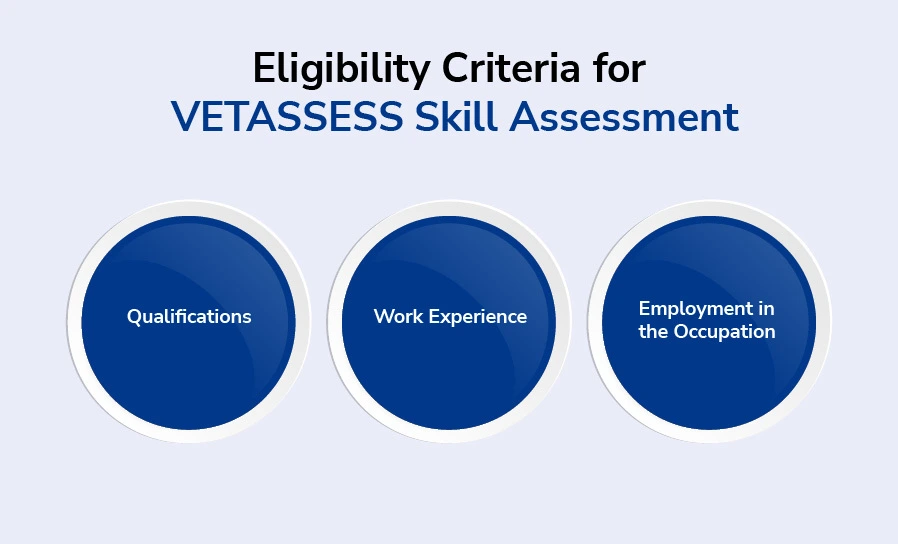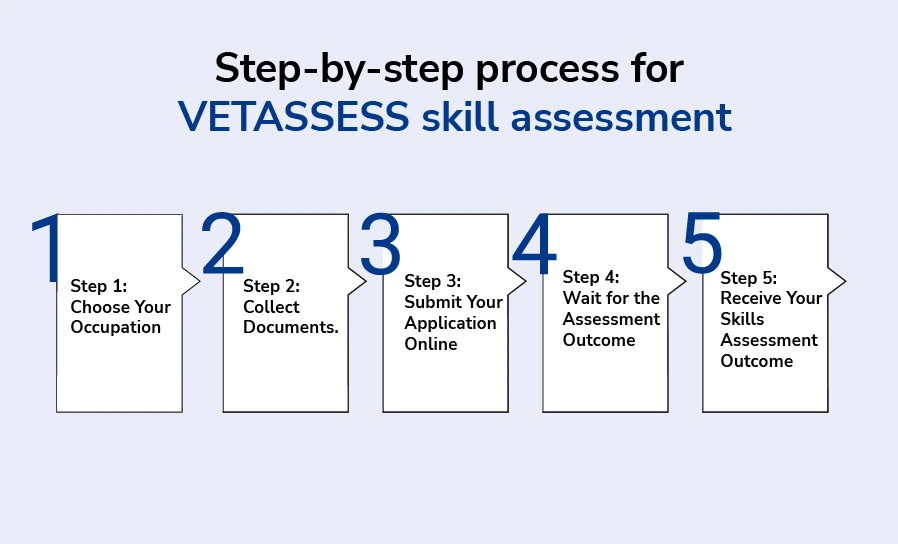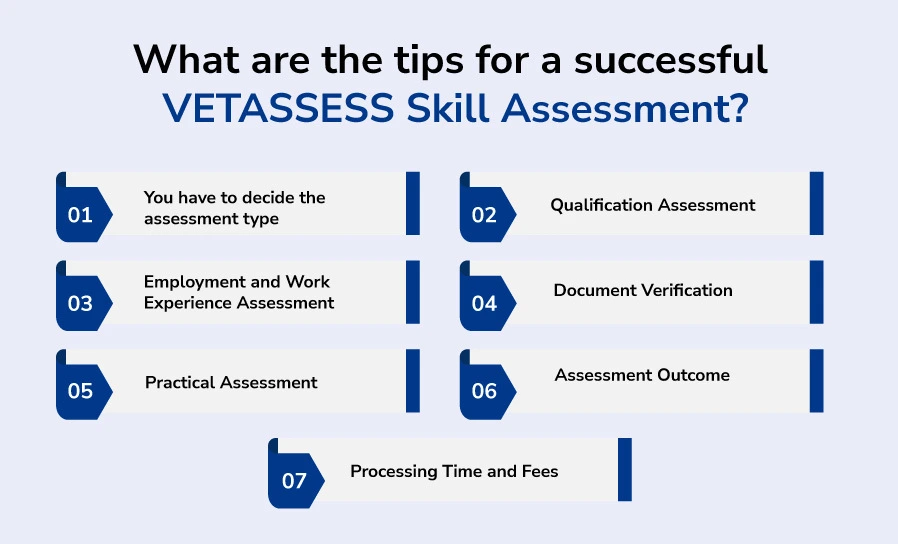
For those seeking a visa to migrate to Australia, higher education qualifications and work experience will require assessment by the VETASSESS. The goal of VETASSESS is to assess the qualifications of people in general and particular trades for various positions.
This guide offers a detailed view of the VETASSESS Skills Assessment, addressing eligibility criteria, the application process, required documents and fees, time commitment, and submission advice.
What is the VETASSESS?
VETASSESS is a government-approved authority that assesses the qualifications and work experience of skilled migrants. VETASSESS will evaluate the level of education and experience equivalent to that stated in ANZSCO for the nominated occupation.
The VETASSESS skill assessment is the official evaluative effort of your qualifications, skills, and work experience to ascertain their equivalence with those recognised in Australia.
Whether applying for a General Professional Occupation or a Trade Occupation, there are certain requirements that the assessment process demands: immaculate preparation, honest documentation, and an in-depth understanding of the specific requirements for any chosen occupation.
Who Needs Assessment from VETASSESS?
You should apply for a VETASSESS skill assessment when you,
Have an Australian skilled visa application such as Subclass 189, 190, or 491.
Have a nominated occupation assessed by VETASSESS.
You need to show that your qualifications and work experience meet Australian standards.
If your occupation is with a different assessing authority, i.e., an engineer, then your assessing authority would be Engineers Australia; you would have to get evaluated through that particular organisation instead.
Why do you need a VETASSESS skills assessment?

A VETASSESS skills assessment is a crucial requirement for skilled migration visa applications to Australia.
Here are the reasons why it is important:
1. You require a visa for skilled migration
If applying for any sub-class that falls under this category, like:
- Subclass 189 (Skilled Independent Visa)
- Subclass 190 (Skilled Nominated Visa)
- Subclass 491 (Skilled Work Regional Visa)
One must provide a positive skills assessment showing you have the requisite qualifications and work experience per your nominated occupation. Otherwise, your visa application will not go through.
2. Evaluate your qualifications
The VETASSESS helps determine if your educational qualifications meet Australian standards, which are those applied for the Australian Qualifications Framework (AQF). Ensure your degree, diploma, or certification meets the level necessary for your occupation.
3. Relevant work experience
VETASSESS checks your work experience to determine
- The relevance of your work roles to the nominated occupation.
- The length and continuity of your employment.
- Your job descriptions match the tasks quoted under the ANZSCO code for your role.
4. Meet the Australian Standards
Australia has high standards for professionalism and trade occupations. The VETASSESS assessment confirms that:
- You have the skills and competencies required to perform the job from an Australian perspective.
- Your qualifications are authentic and correspond to industry standards.
5. You require State or Territory Nomination
For visas such as Subclass 190 or 491, if you are applying for state or territory nomination, a positive skills assessment from VETASSESS will have to be met on their part in most of the Australian states.
6. Open Doors for Your Career in Australia
Beyond just migration, an assessment of your qualifications could assist in:
- With an application for jobs in Australia.
- Professional licencing in certain regulated industries.
- Further study opportunities if one wants to learn in Australia.
Eligibility Criteria for VETASSESS Skill Assessment

The eligibility criteria for a positive VETASSESS skill assessment are as follows:
1. Qualifications
An Australian Qualifications Framework diploma, bachelor’s degree, or higher in a relevant field will be necessary depending on your occupation.
2. Work Experience
Relevant work experience must include working in the nominated occupation or a closely related occupation.
The total number of years depends on the level of skill of your chosen occupation.
At one instance, one year of work experience must be post-qualification.
3. Employment in the Occupation
Under your employment history, the activities performed need to be similar to those mentioned in the ANZSCO description of your nominated occupation.
Step-by-step process for VETASSESS skill assessment

This is the formal and prescribed procedure for applying for the VETASSESS Skill Assessment:
Step 1: Choose Your Occupation
Visit the VETASSESS website to see if your occupation is listed under the General Occupations or Trade Occupations section. Read occupation descriptions and skill-level requirements carefully.
Step 2: Collect Documents
You will need to provide the following things:
- Identification
Passport, birth certificate, or national ID.
- Qualification Documents
Academic transcripts, certificates, diplomas, and degrees.
- Evidence of work experience
Payslips, letters of reference, tax returns, contracts, and job descriptions.
- Resume or professional CV
Names of positions, responsibilities, titles, and dates for each job.
- Skill video
For trade occupations, you also may need to include a video demonstrating your practical skills, if applicable.
Step 3: Submit Your Application Online
Create an account in the VETASSESS portal and fill out the online application form. Moreover, upload scanned documents and pay assessment fees.
Step 4: Wait for the Assessment Outcome
VETASSESS will evaluate the documentation, verify your qualifications, and review your work experience. They may require further documentation from time to time.
Step 5: Receive Your Skills Assessment Outcome
You will thus receive the results:
- Positive assessment
Your qualifications and work experience are satisfactory for migration.
- Negative assessment
Your qualifications or experience do not meet the threshold.
What are the tips for a successful VETASSESS Skill Assessment?

The VETASSESS skills assessment is vital for skilled migration to Australia. It simply helps the Australian government verify that your qualifications and work experience meet Australian professional standards. Each of the parts of the process is analysed in detail below.
1. You have to decide the assessment type
Before your application process starts:
Defining Your Nominated Occupation:
Use the Australian and New Zealand Standard Classification of Occupations (ANZSCO) list to find out the correct code that applies to your job role.
Every occupation has a code and a description that contains all the details concerning the tasks associated, the qualification required, and the skill level.
2. Qualification Assessment
This is where you find out if VETASSESS regards your qualifications as to whether they match the criteria or level of qualification in Australia.
a. Level of Qualification
You qualify to be equivalent to a diploma, bachelor’s, or higher in the Australian Qualifications Framework (AQF) system.
b. Relevance to Your Occupation
You qualify to be within some speciality area relating to your nominated profession.
c. Accreditation
Was the institution that gave you the degree a recognised university or college?
And whether the VETASSESS verifies that the institution rises to be a recognised one in that domain.
If your qualification does not match with the standards in Australia, it might turn out to bring about a bad assessment.
3. Employment and Work Experience Assessment
Careful analysis of your employment experience involves looking at various parameters’ relevance to the Work category of the ANZSCO code, including the following:
a. Relevance
Your employment experience is relevant to the tasks defined under your ANZSCO code.
b. Duration
Have you met the minimum required years of experience, usually: one year post-qualification?
c. Consistency
Are your job titles, duties, and employment dates consistent in all your documents?
4. Document Verification
A range of documents is required to support the application made by VETASSESS:
a. Identity Documents
Passport, national ID, or birth certificate.
b. Educational Documents
Degree certificates, transcripts, and course descriptions.
c. Employment Evidence
Reference letters are given by employers (to include duties, duration, and roles).
Payslips, tax records, contracts, and any supporting documents.
d. CV/Resume
Detailed description as a thorough and up-to-date description with job history.
For trade occupations, you may be required to submit:
- Skills Evidence: Videos demonstrating your skills (where applicable).
- Trade licencing or apprenticeship certificates.
5. Practical Assessment
For applicants seeking trade occupations, possible assessments include:
a. Technical Interview
Done online means or face-to-face to assess theoretical knowledge.
b. Practical
In a simulated work environment, you would be asked to carry out some tasks to assess skills.
Such assessments are crucial for trades like plumbing, electrical work, automotive mechanics, etc.
6. Assessment Outcome
Upon completion of assessing your application, you will be informed of:
a. Positive Skills Assessment
Your qualifications and experience are what Australia requires.
b. Negative Skills Assessment
Your application did not meet the requirements (with reasons provided).
In case you do not agree with the assessment outcome, you can:
c. Request a Review
In case you believe it was erroneously assessed.
d. Submit further evidence
Statements/letters can be attached as supporting documents to your case.
7. Processing Time and Fees
a. General Occupations
10–12 weeks (standard) or 10 business days (priority processing).
b. Trade Occupations
Varies based on practical assessments.
Fees range from AUD 1,050 to AUD 2,000, depending on occupation and type of assessment.
Conclusion
A positive VETASSESS skill assessment is not just a blessing- it’s a stamp of endorsement indicating that someone travelling through a professional career is on the right track to set foot in a different world of opportunity altogether.
This entire guide is all you need to have to get started. Staying organised and focused on preparation will bring you one step closer to your Australian migration goals.
While the process may seem daunting, having the best approach towards it, like aligning your work experience with ANZSCO descriptions, providing good detail in your employment references, and ensuring you have documented your qualifications well, can enhance your chances of having success.
FAQs
1. How long does VETASSESS take for a skills assessment?
The general occupation takes 10 to 12 weeks, whereas the trade occupation takes 8 to 10 weeks for a skill assessment.
2. How do I get a positive VETASSESS skill assessment?
To get a positive VETASSESS skill assessment, the following things can be considered:
- Choose the right ANZSCO code
- Submit complete, certified documents
- Match work experience with ANZSCO duties
- Meet the required work experience
- Ensure consistency in all details
3. What IELTS score is required for VETASSESS?
VETASSESS does not require the IELTS score for skills assessment.
But for your visa consideration:
Competent English: IELTS 6.0 in each band
Proficient English: IELTS 7.0 in each band
4. Is the VETASSESS test hard?
The VETASSESS test is not hard but can be challenging depending on how you prepare.
5. Is there an interview in VETASSESS?
VETASSESS generally does not require an interview; they evaluate your qualifications, experience, and supporting documents.

